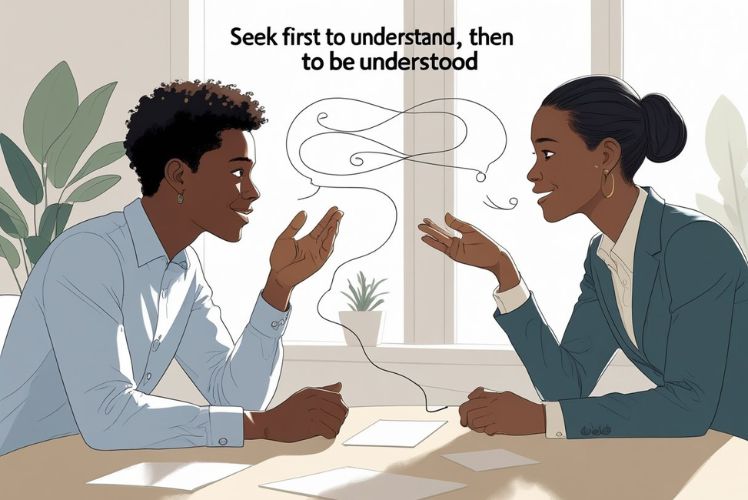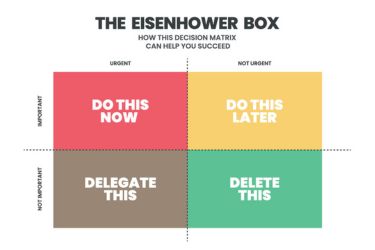Most of us want to be heard and understood, but we often overlook listening to others. The core idea of Habit 5 from Stephen Covey's Seven Habits is to seek first to understand, then to be understood. This is about truly listening to people so we can see things from their point of view before sharing our own.

When we practise empathic listening, we build trust and cooperation in our relationships. This habit helps us move away from simply waiting for our turn to talk and encourages us to focus on real understanding. By doing this, we create a better environment for both personal and professional communication.
Key Takeaways
- Habit 5 focuses on understanding others before expressing ourselves.
- Empathic listening strengthens trust and teamwork.
- Small daily changes in how we listen lead to better communication.
Understanding Habit 5: Seek First to Understand, Then to Be Understood

Habit 5, introduced by Stephen Covey in The 7 Habits of Highly Effective People, urges us to listen with empathy before expressing our own ideas. This habit emphasises respect, deeper understanding, and effective communication in both personal and professional relationships.
Meaning and Origins of Habit 5
Habit 5—Seek First to Understand, Then to Be Understood—asks us to prioritise listening over speaking. Covey believed that true understanding comes from empathetic listening, which means paying careful attention to both words and feelings. We do not interrupt, judge, or formulate responses in our minds while the other person is talking.
Covey drew on principles of respect and empathy when developing this habit. By focusing on others' perspectives, we show that their opinions matter. The influence of Habit 5 can be traced to foundational ideas in psychology and counselling, where reflective and active listening help build trust.
Habit 5 is not about passive agreement. Instead, it is an active process where we validate others' experiences. When we demonstrate real effort to understand, we open the door for honest, meaningful conversations.
Significance Within The 7 Habits Framework
Within the framework of the 7 Habits of Highly Effective People, Habit 5 is a turning point. The first three habits focus on personal growth—being proactive, beginning with the end in mind, and putting first things first. Habit 5 shifts the focus outward, moving from independence to interdependence.
This habit lays the groundwork for effective teamwork and collaboration. Without the foundation of mutual understanding, the later habits—like synergy and win-win thinking—are difficult to achieve. Covey placed Habit 5 at the centre of the public victory habits, highlighting its importance for building positive relationships.
By practising Habit 5, we foster open dialogue and reduce misunderstandings. The 7 Habits emphasise that real effectiveness depends not just on what we say, but on the willingness to listen first.
Role in Interpersonal Relations
In everyday situations, Habit 5 changes how we approach our relationships. When we seek first to understand, we practise empathetic listening, which helps us respond thoughtfully. This can prevent conflict and help us find solutions that benefit everyone.
Listening first sends a clear message: we care about others' viewpoints. This builds trust and makes it easier for us to express our own needs. Covey notes that relationships thrive when both understanding and being understood are present.
When we use Habit 5 in our teams, families, and friendships, we move beyond surface conversations. We address the real reasons behind opinions and actions. This habit is key for clear, honest, and effective interpersonal communication.
The Principle of Empathic Listening

Empathic listening is key for strong communication and trust between people. When we truly listen and understand first, we improve our relationships, avoid misunderstandings, and help solve problems more effectively.
Definition and Key Concepts
Empathic listening means we focus on understanding the other person’s feelings and point of view before thinking about our own response. Instead of interrupting or judging, we give the other person space to share openly. Our goal is to hear with our ears, see with our eyes, and connect with our hearts.
This approach goes beyond hearing words. It asks us to notice tone, expression, and body language as well. While active listening repeats back facts, empathic listening also reflects emotions and intentions. We show that we value what is being said and that we care about the speaker.
Key to this habit is Covey’s advice to “seek first to understand, then to be understood.” By making understanding our first goal, we lay the groundwork for honest and meaningful exchanges.
Levels of Listening
Not all listening is the same. We can practise different types, from ignoring someone entirely to paying close, full attention. Covey describes these levels in order of depth:
- Ignoring: We don’t listen at all.
- Pretend Listening: We act attentive but aren’t really focused.
- Selective Listening: We pick out only bits that interest us.
- Attentive Listening: We hear the words and follow what’s being said.
- Empathic Listening: We try to fully understand meaning and feelings.
Empathic listening is the highest level, as it requires effort, patience, and an open mind. It helps prevent quick reactions or misunderstandings and lets us grasp what the person truly means.
Impact on Relationships
When we practise empathic communication, we build stronger trust and respect in our relationships. Listening deeply shows others that we value their views and emotions, not just their words. This reduces defensiveness and increases openness.
Empathic listening is especially effective in conflict or stressful situations. By making people feel heard, we help calm emotions and create a path to real solutions. When others feel understood, they’re more willing to listen to us in return. This leads to better teamwork, smoother conversations, and more effective problem-solving in our personal and professional lives.
Practical Steps to Improve Understanding

Improving our ability to seek first to understand, then to be understood, requires concrete changes in our everyday conversations. By using specific listening methods, showing empathy, and dealing with barriers, we can communicate more effectively and build stronger relationships.
Active Listening Techniques
Active listening means giving someone our full attention when they speak. We should set aside distractions, make eye contact, and avoid interrupting. It's helpful to nod, use small verbal cues like “I see” or “Go on,” and focus on both the speaker's words and tone.
To check our understanding, we can paraphrase what the other person has said. For example, we might say, “So you’re saying you felt left out during the meeting?” This helps the other person know we are truly listening.
Checklist for active listening:
- Remove distractions (put away phones, close laptop)
- Make eye contact
- Avoid interrupting
- Summarise or repeat key points
Using these habits allows us to seek first to understand and makes the conversation feel more genuine and respectful.
Developing Empathic Communication
Empathic communication is about listening with the intent to understand the other person’s feelings and point of view. We do this by noticing body language, asking open questions, and offering support without judgement. We take time to tune into what the person is experiencing, not just their words.
When practising empathic listening, we might say things like, “That sounds really difficult,” or, “I can see why you’d feel frustrated.” These responses show we care about their emotions.
Empathic communication builds trust and helps others feel valued. It reminds us to look beyond our own perspective and connect on a deeper level. This approach is at the core of seek first to understand and encourages better teamwork and friendship.
Overcoming Common Barriers
Misunderstandings often come from distractions, assumptions, or a rush to respond. If we focus on our own reply instead of truly listening, we miss important details. Judgment, bias, and lack of patience can also block empathic communication.
To overcome barriers, we should:
- Pause before replying
- Double-check what we’ve heard
- Keep an open mind
- Reflect on our own biases
Sometimes, it helps to write down what the other person says or to talk in a quiet setting. By recognising and tackling these obstacles, we make it easier to seek first to understand in every conversation.
Achieving Mutual Understanding: Being Understood

Mutual understanding depends on both listening and clear self-expression. When we share our ideas with empathy and clarity, we help others see our point of view and find win/win solutions.
Expressing Your Ideas Effectively
To be understood, we must communicate our thoughts in a simple and organised way. Using clear language, avoiding jargon, and stating our main points early help others follow our reasoning. It is helpful to use short sentences and focus on what matters most.
We should listen to the response and check for understanding. Asking follow-up questions or using phrases like, “Does this make sense?” improves communication. Sharing relevant examples supports our ideas.
Using bullet points or numbered lists can also make complex information easier to follow:
- State your idea simply
- Give reasons or evidence
- Check for understanding
This approach allows us to contribute to empathic communication and paves the way for others to respond with openness.
Ethos, Pathos, and Logos in Communication
Ethos, pathos, and logos are three ways we persuade others when explaining our ideas.
- Ethos is about building trust. We do this by being honest and respectful.
- Pathos appeals to emotions. Sharing personal stories or showing understanding creates connection.
- Logos means using logic and reason. Facts, examples, and clear reasons are vital.
By blending these three elements, we increase our chance of being understood. For instance, when proposing a win/win solution, we share facts (logos), show empathy (pathos), and present ourselves as trustworthy (ethos).
A balance of these can look like this in practice:
| Element | Purpose | Example Action |
|---|---|---|
| Ethos | Build trust | Be honest and reliable |
| Pathos | Connect emotionally | Acknowledge others’ feelings |
| Logos | Show logical reasoning | Share data or examples |
Balancing Courage and Consideration
To reach true understanding, we must be both courageous and considerate. It takes courage to share our honest thoughts, especially if they may not be popular. However, being too forceful can damage trust and block empathic communication.
Consideration means respecting others' views and feelings. We aim to state our needs directly, yet kindly. Using “I” statements and keeping a calm tone helps avoid conflict.
When we balance courage and consideration, we support open dialogue, invite feedback, and help everyone feel heard. This balance builds stronger relationships, making it easier to find solutions where everyone benefits. We move closer to win/win outcomes, as everyone’s voice is respected.
Habit 5 in Daily Life and Professional Settings
Using Habit 5—seek first to understand, then to be understood—helps us communicate better, make fewer errors, and build trust. Being understood comes after making sure we have listened with genuine intent and empathy.
Practical Examples and Scenarios
In our daily lives, Habit 5 often means listening to our friends or family members without interrupting or judging. When a child talks about a bad day at school, we pause, listen, and ask open questions instead of jumping in with advice. This lets them know we value what they say.
At work, meetings can run more smoothly if we first understand a colleague’s point of view. For instance, if a team member expresses concern about a deadline, we ask for specifics and listen before offering solutions. When we are clear about what matters most to them, misunderstandings are less likely.
Everyday Steps:
- Put away distractions when someone speaks to us.
- Restate what we hear for confirmation.
- Hold off on sharing our own view until others feel heard.
Transforming Interpersonal Relations
Empathic listening forms the backbone of better relationships. When we focus on understanding others first, it breaks down barriers and paves the way for open communication. This habit is especially helpful in resolving personal disagreements.
Practising Habit 5 can turn tense situations into productive conversations by making people feel respected. Large conflicts at work, like miscommunication between departments, often start with people seeking to be understood first rather than listening. By shifting our approach, trust increases and relationships become stronger.
In group projects, when each team member feels heard, they are more likely to contribute honestly. This shared respect fosters unity, making collaboration productive and helping avoid feelings of resentment.
Fostering Win/Win Solutions
Seeking first to understand lays the groundwork for win/win solutions. When both sides feel heard, it becomes easier to create outcomes where everyone benefits. In business negotiations, listening carefully to what the other party truly needs allows us to find solutions that address everyone’s key interests.
For example, in a workplace dispute over shared resources, instead of insisting on our way, we listen to the other team’s challenges and brainstorm together. We look for options that meet both teams’ goals rather than creating winners and losers.
Using this habit to reach a win/win outcome not only solves the immediate problem but also builds a culture of cooperation. People are more willing to participate in future solutions if they know their concerns will always be considered.
Frequently Asked Questions
We explore how Habit 5, "Seek first to understand, then to be understood", is put into practice in everyday life. From practical examples to its connection with Covey’s guiding ideas and how we can use it in school and group settings, these answers offer clear guidance and examples.
What are practical examples of applying 'Seek first to understand, then to be understood' in daily interactions?
When we listen to our friends without interrupting, we show this habit. For example, if a classmate is upset, we listen carefully instead of jumping in with advice right away.
At work, we might ask clarifying questions before sharing our own ideas in meetings. This approach helps us avoid misunderstandings and makes conversations smoother.
Can you explain the underlying principle of 'Seek first to understand, then to be understood' in Covey’s philosophy?
Covey’s principle is based on showing real respect for others by listening before speaking. Our focus is to hear what someone means, not just their words.
This habit encourages empathy and patience. We aim to understand others' views deeply before we share our own perspective.
How can students incorporate the habit of 'Seek first to understand, then to be understood' in their academic and social lives?
Students can practise active listening when working with classmates on projects or in group discussions. Taking time to listen can help solve problems and create stronger partnerships.
In social life, we can avoid quick judgements by listening to our friends' opinions. This can prevent arguments and misunderstandings.
In what ways does the habit 'Seek first to understand, then to be understood' relate to the other six habits proposed by Stephen Covey?
Habit 5 connects to habits about teamwork, respect, and self-improvement. For instance, thinking "win-win" (Habit 4) and seeking synergy (Habit 6) both rely on understanding others’ viewpoints.
By listening first, we build trust and better relationships. These steps make the other habits easier to use in daily life.
What activities can reinforce the practice of 'Seek first to understand, then to be understood' in a teamwork context?
Role-playing exercises that focus on listening skills are effective. Team members can take turns sharing their thoughts while others practise summarising what was said without adding their views first.
Reflective listening games, where we repeat what someone has said to make sure we understand, also build this habit. Group feedback sessions after activities can help us learn from our experiences.
What is the origin of the quote 'Seek first to understand, then to be understood', and how does it fit into Covey's overall teachings?
Stephen Covey developed the phrase as the fifth habit in his book "The 7 Habits of Highly Effective People". The habit is rooted in the idea of empathic communication.
In Covey’s system, this approach supports better relationships and helps us solve conflicts more effectively. It is central to creating lasting cooperation and results.

















